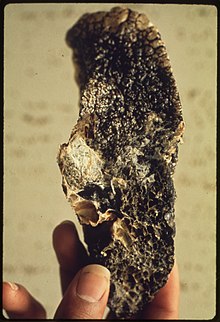Coal workers' pneumoconiosis (CWP), also known as black lung disease or black lung, is caused by long-term exposure to coal dust. It is common in coal miners and others who work with coal. It is similar to both silicosis from inhaling silica dust and asbestosis from inhaling asbestos dust. [1] Inhaled coal dust progressively builds up in the lungs and leads to inflammation, fibrosis, and in worse cases, necrosis.
Coal workers' pneumoconiosis, severe state, develops after the initial, milder form of the disease known as anthracosis(from the Greek άνθρακας, or anthracas —coal, carbon). This is often asymptomatic and is found to at least some extent in all urban dwellers[2] due to air pollution. Prolonged exposure to large amounts of coal dust can result in more serious forms of the disease, simple coal workers' pneumoconiosis and complicated coal workers' pneumoconiosis (or progressive massive fibrosis, or PMF).[3] More commonly, workers exposed to coal dust develop industrial bronchitis,[4] clinically defined as chronic bronchitis (i.e. productive cough for 3 months per year for at least 2 years) associated with workplace dust exposure. The incidence of industrial bronchitis varies with age, job, exposure, and smoking. In nonsmokers (who are less prone to develop bronchitis than smokers), studies of coal miners have shown a 16%[5] to 17%[6] incidence of industrial bronchitis.
In 2013 CWP resulted in 25,000 deaths globally—down from 29,000 deaths in 1990.[7] However, a later 2018 study by the National Institute of Occupational Safety and Health shows a resurgence of the incurable respiratory illness, the highest rate recorded in roughly two decades.[8]
https://en.wikipedia.org/wiki/Coalworker%27s_pneumoconiosis

No comments:
Post a Comment